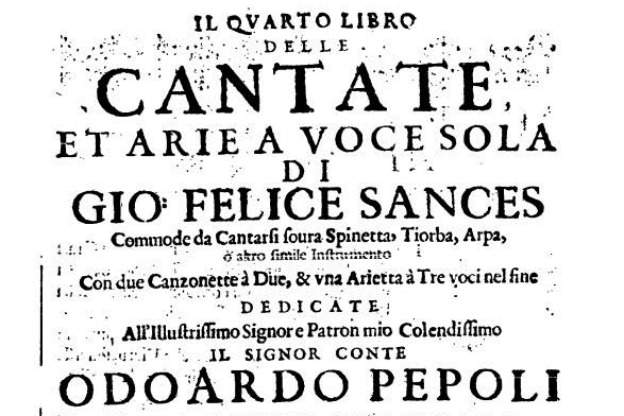
Self-accompanied
An interesting aspect of this recording is that tenor Bud Roach doesn’t sing with an accompanist, but rather accompanies himself on the Baroque guitar. It was actually a common practice in the 17th century, though in classical music concerts nowadays, we are used to almost always seeing singers perform together with a separate accompanist. But back then-as is now in a lot of folk and pop music-performers accompany themselves all the time on guitar. Think of Joni Mitchell, or Eric Clapton, or Jimi Hendrix, or Brad Paisley, or Beck…
Giovanni Felice Sances
Born in Rome in 1600, Sances was enrolled as a boy soprano at the age of nine in the Collegio Germanico in Rome. And this was a serious commitment. The school provided extensive musical training and wanted to reap the benefits of that training in their chapel and church services. So when Sances’ Dad withdrew him from the college in 1614, he was thrown in prison for breach of contract until things could get sorted out.
Sances’ musical training did eventually pay off. He worked as a musician in Bologna, Venice, and Vienna, and in addition to his solo songs, he composed some six operas along with a fair amount of sacred music.
Alfabeto notation
Sances' fourth book of cantatas, arias, canzonettas, and ariettas was published in 1636. In addition to the vocal line, the score includes an accompaniment written in “alfabeto” notation for the strummed guitar. Quite often, lutes are considered the preferred plucked continuo instrument for 16th- and 17th-century repertory, but as it turns out, the guitar was also hugely popular. Lutes were more intricate instruments to master in terms of technique. They were physically larger and had many more strings, generally fourteen to nineteen courses. Guitars were more approachable, a perfect little instrument with which a singer, without too much training or experience, could easily pick up and play back up harmonies for himself.
Alfabeto notation was simpler too. Unlike lute tablature, the guitar was well suited to the alfabeto system of block harmonies that could easily be strummed. No intricate counterpoint was required—rather, certain chords were designated with letter symbols in shorthand without need to actually spell out individual notes on a staff.
Bud Roach, tenor and guitar
Bud Roach is perhaps a modern representation of the kind of 17th-century singer who would have used alfabeto notation a few hundred years ago. Roach was trained as an oboist and worked for many years as a symphony orchestra musician. It was only when he transitioned to singing early music in 2006 that he decided to also learn the guitar—for him, the alfabeto song repertory seemed a good match.
Admittedly, Roach is not a trained guitarist, and this is sometimes apparent on his recording, yet there is something to his approach that reflects the nature of these pieces, which were essentially 17th-century pop tunes. And just like love and breaking up are central themes of today’s Top 40 on the radio, Sances’ arias are all about love too: bitter love, hopeful love, cheating love, love-true love, passionate love and yes, some naughty love as well.
Much of Sances’ music is too little-known or under-performed, so many thanks to Bud Roach for bringing these entertaining pieces to our ears once again.









